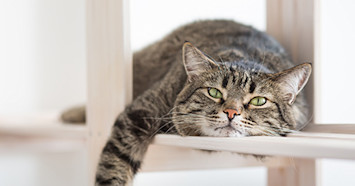
You may have heard of this serious condition, but did you know that autumn is the most common time of year for male cats to "block?" Why this time of year?
Cats typically drink plenty of water during the hot summer months. As the staggering summer heat eases up and the seasons quickly shift to cooler fall temperatures, cats are more likely to consume less water. Noticeable effects can even be seen in indoor cats.
Although any animal is susceptible to a urethral obstruction, male cats are at greater risk for urethral blockage than dogs or female cats because their urethras are narrow and long, making them easier to plug.
A Detailed Look at Male Cat Urinary Blockage
Feline urethral obstruction (the “blocked cat”) is a potentially fatal condition, usually seen in male cats, during which urine is prevented from leaving the bladder. This happens when small stones and protein-rich material are formed that literally block the flow of urine from the bladder through the urethra. The urethra may be plugged with mucus, urinary sediment, inflammatory cells, or small bladder stones. Diet and bladder infections can have a role in the formation of urinary stones and sludge.
How serious is this?
Urethral obstructions are life threatening! If urine is prevented from exiting the bladder, pressure within the urinary tract can damage the kidneys. Urine contains metabolic waste products that the body must eliminate; urethral obstruction causes these toxins to build up. In addition, the bladder wall may be stretched to the point where muscle function is lost; in the worst cases, it ruptures.
A urethral obstruction is an emergency situation and you should go to your veterinarian immediately if you suspect that your pet is “blocked.” If not treated quickly, pets with a urinary obstruction can die a painful death from complications.
Signs of Urinary Blockage in Male Cats
If your cat is straining to go to the bathroom or tries multiple times to urinate and produces a few drops of urine or none at all, chances are good that he is completely or partially blocked.
As the condition progresses, he may show evidence of abdominal pain and howl when touched or when trying to urinate. Your normally sweet cat may even swat or bite you when you try to touch him. This is because he feels horrible. Within 24 hours, he may become lethargic, not wanting to get up, move, or eat.
If your cat is straining to go to the bathroom, vocalizing excessively, or seems to be in pain when his abdomen is touched, a veterinarian should check him IMMEDIATELY!
What Happens at the Vet
As soon as you arrive at your veterinarian’s office, your cat will be examined to determine if his bladder is enlarged and whether an obstruction is likely. This is a quick and easy diagnosis. If an obstruction is confirmed, your cat will likely be rushed to the back where emergency treatment and stabilization will be initiated.
Your veterinarian may recommend any or all of the following diagnostics and procedures:
Blood work to assess toxin levels and hydration status
Urine exam to look for an infection and/or crystals
Urine culture to determine if there is an infection and, if so, what bacteria may be responsible
X-rays to look for bladder or urethral stones
IV catheter placement, which allows for fluids and medications to be administered
Removal of urine directly from the bladder, which allows for easier urinary catheter insertion
Urinary catheter placement, which provides a way to flush the bladder and keep it empty for several days while inflammation subsides
Treatment for Urinary Blockage in Cats
Treatment involves IV fluids, antibiotics, medications to relax the urethra in order to allow material to pass through it, surgery to remove bladder stones, and sometimes a surgery called a “P.U.” or a perineal urethrostomy. This surgery makes the urethral opening permanently larger, thus reducing the risk of future obstructions.
Vet Tip: If your cat does block, you should discuss with your vet if he/she thinks your cat is a good candidate for a P.U. Many vets are hesitant to mention this initially, as the cost to hospitalize a blocked feline can easily reach $1,000. Sadly, if vets initially disclose that the condition might later require a P.U. surgery, yet another pricey invoice, many pet parents choose euthanasia. Please forgive us if your veterinarian doesn't mention this. If you were faced with cat owners choosing euthanasia after learning that this isn't a one-time solution, you would quickly learn to keep your mouth shut and only initiate that discussion when and if it is applicable.
How to Prevent Urinary Blockage in Cats
Unfortunately, it is very difficult to prevent feline urethral obstructions, as it is not always known what causes them in the first place. Bladder infections may have a role in the formation of urinary sediment, stones, and scar tissue, so infections should be treated promptly.
Increasing water intake may also be beneficial. Several diets can help reduce the risk of urethral obstruction in cats that are prone to this problem. Your veterinarian can tell you if your cat should be on a special diet to reduce the risk of urethral obstruction. Wet diets are higher in water, and therefore keep the urine more dilute. Running fountains also encourage many cats to drink more water, but some cats refuse to use these fountains all together.
Keeping your cat at a healthy weight is a final way to help prevent the chance of urethral obstruction. Though we don't quite understand the connection, overweight neutered male cats represent the majority of blocked pets.